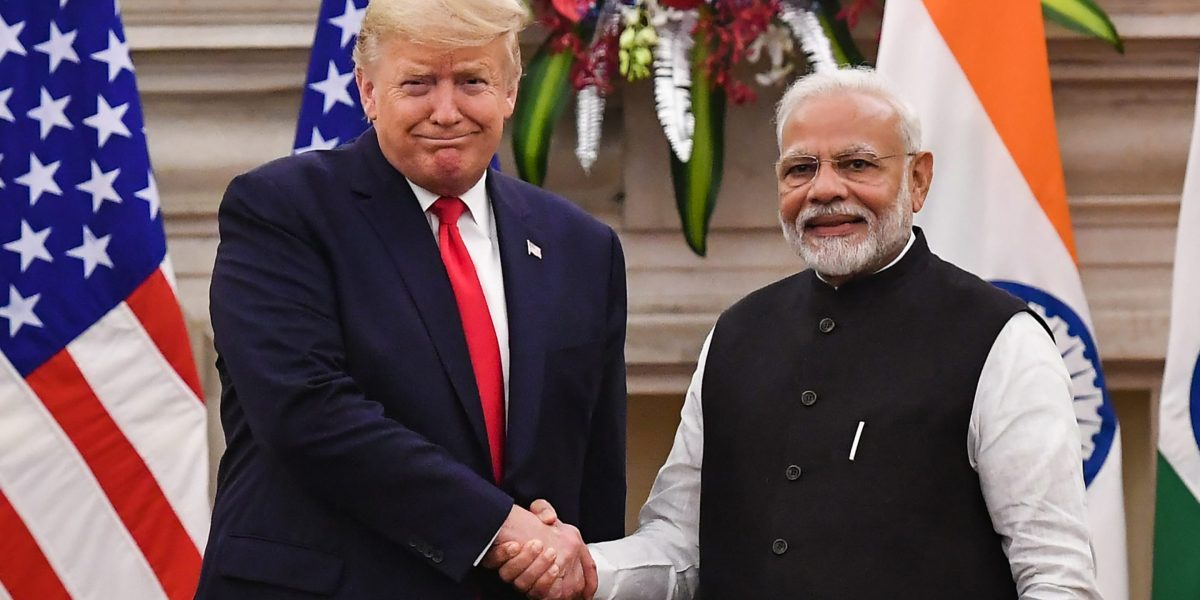Few leaders in Asia are more happy to see Donald Trump heading back to the White House than Indian Prime Minister Narendra Modi.
Modi became one of the first major leaders to congratulate Trump on his “historic” win in Tuesday’s election, posting his message alongside photos of the two men holding hands at a rally of thousands of supporters in Houston five years ago. He quickly followed that up with a phone call.
Trump’s return gives Modi a chance to bolster India’s image with the U.S. and its allies, which have increased scrutiny recently on the nation’s close ties with Russia’s Vladimir Putin and its role in violence against Sikh activists in the U.S. and Canada. Canadian Prime Minister Justin Trudeau last year alleged that Indian government agents have been involved in killing dissidents living abroad, and cases are now making their way through U.S. and Canadian courts.
Officials in New Delhi, who asked not to be identified, expect a new Trump administration to be less stringent in demanding accountability from India’s government for its alleged involvement in extra-judicial killings in Canada and the U.S. The Biden administration had been pushing India to probe and prosecute the officials allegedly involved. India has officially denied orchestrating any assassinations.
Analysts and officials believe that the U.S. under Trump will continue a years-long effort to cultivate India as a strategic partner against a more assertive Beijing, an effort that has won India big new investments from U.S. companies like Apple Inc.
“Trump will continue to view China as the greatest geopolitical challenge and, in that equation, India’s long-term value as a strategic partner for the United States will be unchallenged,” said Irfan Nooruddin, a professor of Indian politics at Georgetown University. “While military co-operation will continue with Trump, the question really is whether the good relations will spill over to the benefit of the broader Indian economy and trade.”
Trade Wars
Officials in New Delhi warn that while overall ties may improve, India could see new trade headaches under Trump and reduced cooperation on formerly key areas like technology sharing and defense. Trump has described Modi as the “nicest human being” while also quickly criticizing India for being the “biggest charger” of tariffs.
The U.S. is now India’s biggest trade partner with two-way trade of $119.7 billion in the past fiscal year, up more than a third in five years. The U.S.’s trade deficit with India has steadily widened over the years as it shifted imports away from China. Trump’s plan to impose a 20% import tariff on all countries, and a 60% duty on goods from China could cost India 0.1% of its gross domestic product by 2028, according to estimates from Bloomberg Economics.
An outsized U.S. tariff on Chinese goods may help to drive more trade to countries like India, but there could be negative spillovers too. Officials in New Delhi said they’ll monitor closely if China begins dumping cheap goods in India. If that happens, officials aren’t ruling out imposing higher duties on Chinese goods in response.
New Delhi’s other concern is cooperation in defense and critical technologies. The two countries in August agreed to advance co-production projects on an array of high-tech equipment, including jet engines, unmanned platforms, munitions, and ground mobility systems. The two sides are also working on a cooperation initiative around “critical and emerging technologies” announced by Modi and Biden last year.
Both efforts could face new challenges given Trump’s protectionist tendencies.
“President Trump may not be as open to sharing technology or let jobs move from U.S. to India,” said Meera Shankar, a former Indian envoy to the U.S.
Russian Ties
Trump’s return makes it easier for India to continue balancing its close links with Russia, which supplies India with cheap oil and military equipment, while keeping U.S. relations on track. Modi has come under pressure from Ukraine and the U.S. for his ties with Putin.
“India would find it easier to navigate its longstanding Russia relationship if President Trump were to negotiate a settlement to end the Ukraine war,” Shankar said.
To be sure, India-U.S. ties have strengthened under both Republican and Democratic administrations, and India diplomats believe that Trump’s hawkish stance on China will ensure that engagement with India will continue.
“He’s been a president before. We all know what are the policies he stands for,” India’s chief economic advisor V Anantha Nageswaran told CNBC TV18. “I don’t see major discontinuity or dislocation from the Indian perspective.”
Trump wasn’t always easy to deal with for India during his first term. In 2019, he pulled India’s designation as a developing nation, a status that had allowed the South Asian country to export thousands of products duty-free to the U.S. India retaliated by imposing higher tariffs on several products from the U.S.
In a second term, he could push hard for tax breaks and lower import duties for American companies like Tesla Inc. and Harley Davidson Inc., Indian officials said. He’s previously cited India’s high import tariffs as a hindrance to Harley Davidson’s expansion.
Another worry for India: Trump’s push for tighter immigration limits. Indians are the largest recipients of H-1B visas to the U.S., widely issued to workers in the tech sector. Trump issued limits on H-1B visas during his first term, and is widely expect to tighten immigration to the U.S. during his second.
“There are two issues in particular that I think he’s going to focus on that could make life difficult for the Indians,” said Milan Vaishnav, director of the South Asia Program at the Carnegie Endowment for International Peace. “One is the whole question of trade, tariffs and market access. And the second is immigration.”

